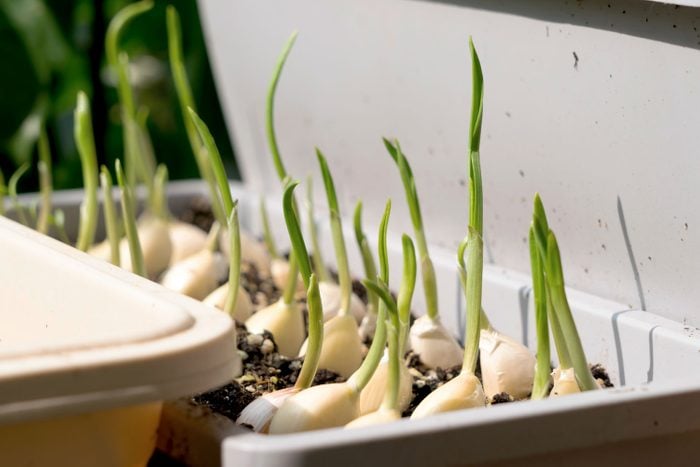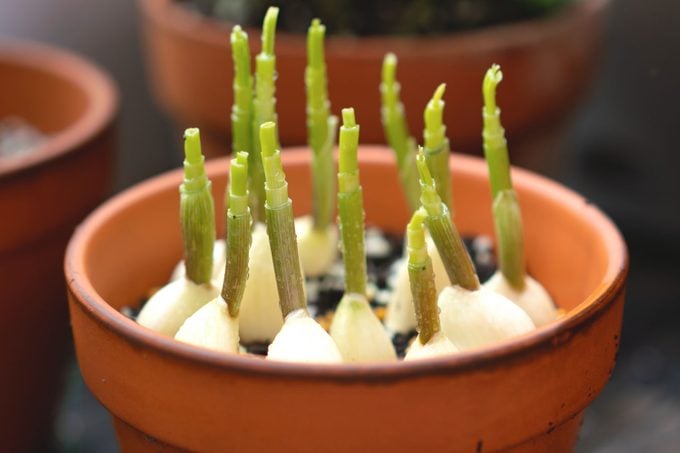You Can Grow Garlic Indoors with Your Grocery Store Sprouted Garlic Cloves
Updated: Dec. 22, 2023

Growing garlic indoors is easier than you'd think; all you need is a grocery store garlic clove to get started.
Garlic is arguably the most essential kitchen staple in your garden, so you’ve likely wondered, can you grow garlic indoors? Though inexpensive, store-bought cloves don’t offer the same convenience or sense of accomplishment as growing your own edible crop. Having it readily on hand would sure make cooking a lot easier, and if you’ve ever experienced your store-bought garlic beginning to sprout, you’re a lot closer to an indoor garden than you might think!
Can You Grow Garlic Indoors?
The good news is that you can successfully grow garlic greens inside. To grow a full bulb, which most people use conventionally, garlic plants need a cycle of cold you likely don’t have indoors. That’s why garlic is planted outdoors in the fall, so it experiences a minimum of six weeks of a winter cold cycle. That’s OK though—you can use the greens you grow in your kitchen to achieve the same flavors for your garlic-heavy dishes, but with a slightly softer edge. And, as a bonus to its culinary benefits, garlic is an attractive indoor plant.
Do you know that with good light and smaller varieties, you can successfully create an indoor vegetable garden and some fruits after you’ve put your outdoor garden to bed?
How to Grow Garlic Indoors

All you need to grow garlic indoors is a pot that is at least 6 inches deep and 6 inches wide. A basic terracotta planter will do the trick, but in a large enough pot, like a metal bucket, you can actually grow a few garlic cloves together, and they look quite nice.
Although many garden centers and websites sell garlic seed, you can use the garlic you get from the grocery store or a farmer’s market. You’ll simply break apart a head (or bulb) of garlic, and without taking off the papery exterior of the cloves, bury them 4 inches deep in the fresh soil you’ve placed in your pot. The pointed tip should face upward and the blunt end (the end pulled off the bulb) should be facing the bottom of the pot—this is where the roots will grow.
You can also add a little Osmocote or another slow release fertilizer to the soil. Plant the cloves as close together as you like, and use all the cloves from the bulb, including the small ones, so long as the cloves aren’t touching each other. Place the pot near a window where it will receive 6 hours of direct sunlight or more a day.
How Often to Water Garlic Indoors
You may consider a self-watering planter for growing garlic indoors. In addition to requiring fewer waterings, these allow the plants to soak in more consistent water, which leads to better flavor in edible plants. If you use a regular planter and hand water your garlic, you should water them every two to three days with a gentle overhead shower. The soil should always be slightly moist, not dry and not soggy.
How Long Does Garlic Take to Grow Indoors?

Within ten days of planting, you should see a pointy green shoot emerge from the soil. They will look like chives or strong blades of grass. From there, the cloves should produce greens consistently over the next few weeks. The greens are the part of the garlic that will eventually become the scape. You should be snipping the garlic greens consistently and can expect a few weeks worth of greens from each clove. The greens will have the same garlicky taste you’re used to in the clove, if just a bit more mellow.
How to Harvest Garlic Indoors
You can begin cutting your greens back to harvest as soon as they’re a few inches tall, always leaving an inch of green shoots behind. This will allow the plant to regenerate shoots over and over for a few rounds. Eventually, the bulb is exhausted and will stop producing shoots, and should then be replaced. Simply remove the spent clove and plant a new one in its place.
